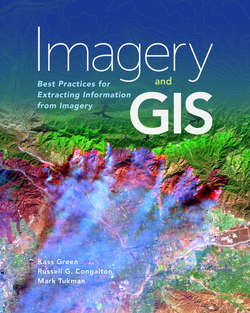Читать книгу Imagery and GIS - Kass Green - Страница 58
На сайте Литреса книга снята с продажи.
Case Study — the Effects of Price and Licensing on the Use of Landsat Imagery
ОглавлениеThe history of Landsat imagery is a good example of how organizational characteristics affect imagery use. Landsat satellite imagery is moderate resolution, multispectral, and funded by US taxpayers. NASA launched the first Landsat satellite in 1972. The spatial resolution was coarse (80 meters) and included only four bands (green, red, and two infrared bands). Technological barriers slowed the use of the imagery because the knowledge base was small, little image processing software existed, and the files were huge for that time, requiring mainframe computers. Most users were NASA or academic scientists and government agencies. Landsats 2 and 3 were similar to Landsat 1.
In 1979, the Landsat program was moved from NASA to NOAA. In 1982, Landsat 4 was launched and included a 30-meter resolution instrument that collected seven bands of imagery, adding two middle-infrared and one thermal band. A similar system, Landsat 5, soon followed in 1984. However, Congress passed the Land Remote Sensing Commercialization Act of 1984, which directed NOAA to migrate Landsat imagery distribution from the federal government to the private sector with the hope that revenue from imagery sales would support the continuation of the Landsat program. As a result, the cost of Landsat imagery increased from $2,800 per scene from NOAA to $6,000 per scene from the commercial company EOSAT, and use of the imagery was license restricted. The demand for imagery sharply declined, as did Landsat research and innovation (Draeger et al., 1997).
In 1992, Congress passed the Land Remote Sensing Policy Act (Public Law 102-555), which ended Landsat commercialization by designating the USGS to take over distribution of Landsat 7 imagery when it was launched (Landsat 6 failed to reach orbit). The act required that imagery be priced at the cost of fulfilling user requests and have no licensing restrictions. Landsat 7 was successfully launched in April 1999, and the USGS initially set the price of a scene at $600. The lower price of Landsat 7 imagery forced the company distributing Landsat 4 and 5 data to match the price of Landsat 7 imagery. Unable to run Landsats 4 and 5 profitably, the company returned its rights to distribute Landsat 4 and 5 imagery to the federal government in 2002. The lower price and unrestricted licensing for all Landsat imagery resulted in a dramatic increase in the operational use of Landsat imagery, with government revenue from image sales growing from $4 million in 1999 to $11 million in 2002. However, access to the imagery was still cumbersome and slow, requiring the manual ordering and writing of CDs.
With improvements in the web and automation of the USGS distribution processes, the agency made Landsat imagery free and downloadable from the web in 2009. As a result, the use of Landsat imagery skyrocketed from 20,000 scenes to 2,000,000 scenes a year, and commercial companies such as Esri are hosting Landsat imagery and processing services, which further increases global access to the imagery.
